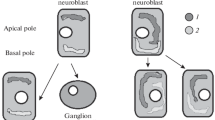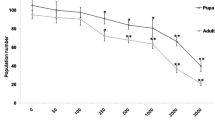Abstract
A line ofGardner's tumorous head stock ofDrosophila melanogaster which is known to contain the inversion In (3L) Payne at varying frequencies, was found to be homozygous for another inversion, probably In (2L)t. The Payne inversion in this line is lethal when homozygous, and is balanced over a recessive lethal gene for which the symbolltl (lethal tumorous larvae) is proposed.ltl is located to the left ofRoughened on the basis of preliminary crossover tests.
Homozygousltl larvae fail to pupate. They survive in the larval state for several days after pupation age. They exhibit a characteristic syndrome of abnormalities, part of which develops gradually during post-pupation age. Typical features of this syndrome are: over-abundance of blood cells, disintegration of fat-body, salivary gland, and parts of the gut, and the presence of brown or black masses (“tumours”). The absolute number of blood cells, and the proportion of different types of blood cells, further, the histolytic changes, in over-agedltl larvae are suggestive of changes which in normal development take place during metamorphosis. A striking feature ofltl are the melanotic pseudo-tumours. These usually float in the haemolymph; sometimes they are associated with organs. Tumour incidence is strongly influenced by genetic modifiers.
A bacterial infection was found inltl. The infection is the consequence, rather than the cause, of some degenerative changes.
The polytene chromosomes in salivary glands, Malpighian tubules, and parts of the gut ofltl larvae show striking abnormalities in their structure. They are shortened and thickened, and in advanced stages may assume a heterochromatine-like aspect through disintegration of the banding pattern. The changes resemble those found in conjunction with microbial infection inRhynchosciara andChironomus. In maleltl larvae the single X chromosome (in contrast to th double X in females) shows “heterocyclic” behaviour in that it is much shorter, wider, and fuzzier than the autosomes.
Some aspects of the complex pleiotropic pattern of pathological changes inltl are discussed. Most abnormalities, including those of the chromosomes, are seen as an indirect effect, depending on physiological conditions in over-aged larvae. This is supported by observations on over-aged larvae of certain mutant types, or following treatment with 5-fluorouracil, which show similar chromosome changes. Several arguments support the view, thatltl larvae fail to pupate because of malfunction of the ring gland. Inability of the hypoderm to react is, however, not excluded as a possible explanation. Results of some transplantation experiments are included in the discussion. They show thatltl imaginal disks are capable of developing into adult organs.
Similar content being viewed by others
References
Barigozzi, C. (1954). The appearance of abnormal groups of cells during or after development: Tumors and Pseudotumors.Proc. IX. International Congress of Genetics I: 338–354.
Berendes, H. D. (1966). Differential replication of male and female X-chromosomes inDrosophila.Chromosoma (Berl.)20: 32–43.
Berendes, H. D. &Th. K. H. Holt (1965). Differentiation of transplanted larval salivary glands ofDrosophila hydei in adults of the same species.J. Exp. Zool. 160: 299–317.
Berseth, W. D. &E. J. Gardner (1961). The behavior in laboratory populations of genes associated with tumorous head expression inDrosophila melanogaster.Genetics 46: 1611–1617.
Bridges, C. B. & K. S. Brehme (1944). The mutants ofDrosophila melanogaster. Carnegie Inst. Washington Publ. 552.
Burdette, W. J. (1954). The effect of larval hormone on tumors.Proc. IX. International Congress of Genetics II: 1160–1163.
Da Cunha, A. B., Z. M. França, A. M. A. Gonçalves, A. Hitelman & M. Garrido (1967). Chromosomal Diseases inDrosophila willistoni Sturtevant.Rev. Brasileira de Biologia 27 (in press).
Diaz, M. &C. Pavan (1965). Changes in chromosomes induced by microorganism infection.PNAS 54: 1321–1327.
Gardner, E. J. (1959). Genetic mechanism of maternal effect for tumorous head inDrosophila melanogaster.Genetics 44: 471–481.
Hadorn, E., W. Gehring &M. Staub (1963). Extensives Grössenwachstum larvaler Speicheldrüsenchromosomen vonDrosophila melanogaster im Adultmilieu.Experientia 19: 530–533.
Hadorn, E., F. Ruch &M. Staub (1964). Zum DNS-Gehalt in Speicheldrüsenkernen mit übergrossen Riesenchromosomen vonDrosophila melanogaster.Experientia 20: 566–567.
Karlson, P. &G. Hauser (1952). Über die Wirkung des Puparisierungshormons auf normale undlgl-Drosophila.Z. Naturforsch. 7: b: 80–83.
Keyl, H. G. (1960). Erhohung der chromosomalen Replikationsrate durch Microsporidieninfektion in Speicheldrüsen vonChironomus.Naturwissenschaften 47: 212–213.
Korf, Susi E. (1956). Melanotic tumors inDrosophila as possible phenodeviants.Amer. Naturalist 90: 270–272.
Matuszewski, B. (1964). Polyploidy and polyteny induced by a hymenopteran parasite inDasyneura urticae.Chromosoma (Berl.)15: 31–35.
Pavan, C. (1965). Nucleic acid metabolism in polytene chromosomes and the problem of differentiation.Brookhaven Symposia in Biology 18: 222–241.
Petersen, G. V. &E. J. Gardner (1965). Development of melanotic tumors in association with failure of pupation inDrosophila melanogaster (Abstract).Genetics 52: 465.
Pflugfelder, O. (1956). Entwicklungsphysiologie der Insekten. 2. Aufl. p. 303–306. Akad. Verlagsges. Geest & Portig, Leipzig 1958.
Rizki, M. T. M. (1957a). Alterations in the haemocyte population ofDrosophila melanogaster.J. Morph. 100: 437–458.
Rizki, M. T. M. (1957b). Tumor formation in relation to metamorphosis inDrosophila melanogaster.J. Morph. 100: 459–472.
Rizki, M. T. M. (1960). Melanotic tumor formation inDrosophila.J. Morph. 106: 147–158.
Roberts, P. A., R. F. Kimball &C. Pavan (1967). Response ofRhynchosciara chromosomes to microsporidian infection.Exp. Cell. Res. 47: 408–422.
Rodman, T. C. (1964). The larval characteristics and salivary gland chromosomes of a tumorigenic strain ofDrosophila melanogaster.J. Morph. 115: 419–446.
Rodman, T. C. &M. J. Kopac (1964). Alterations in morphology of polytene chromosomes.Nature 202: 876–877.
Woolf, C. M. &L. J. Phelps (1960). Chromosomal polymorphism in the tumorous head strain ofDrosophila melanogaster.Science 132: 1256–1257.
Author information
Authors and Affiliations
Rights and permissions
About this article
Cite this article
Kobel, H.R., van Breugel, F.M.A. Observations onltl (lethal tumorous larvae) ofDrosophila melanogaster . Genetica 38, 305–327 (1967). https://doi.org/10.1007/BF01507464
Received:
Issue Date:
DOI: https://doi.org/10.1007/BF01507464




